1.12.2021

Space Force: Weather looks excellent for SpaceX Starlink launch this week

A SpaceX Falcon 9 rocket should lift off into excellent conditions around Cape Canaveral this week, local Space Force forecasters said Sunday.
If conditions remain stable and teams at Cape Canaveral Space Force Station's Launch Complex 40 remain on schedule, a Falcon 9 rocket with dozens of Starlink internet satellites will take flight at 6:20 p.m. Wednesday. Conditions during that instantaneous window stand at 90% "go."
"A rather benign weather regime will remain in place across the Space Coast through the remainder of the weekend into the middle of next week," Space Launch Delta 45 forecasters said in a pre-launch report. "There will be light winds during the launch window and limited low-level moisture. The primary concern for a Wednesday evening launch is a few cumulus clouds with onshore flow."
Post-liftoff conditions, like upper-level winds and weather around the booster recovery zone in the Atlantic Ocean, were all listed as "low risk."
The favorable conditions also extend beyond Wednesday. If SpaceX teams need more time to prepare, the forecast looks identical for a Thursday attempt. Local temperatures are expected to hover around a comfortable 70 degrees at launch time.
The launch marks the 32nd for SpaceX's Starlink internet constellation, which already has roughly 1,700 operational satellites in low-Earth orbit. The company recently said more than 100,000 customers have signed on to receive their user terminals and internet connection packages, which initially cost $499 for hardware and $99 a month thereafter.
Spectators curious about Falcon 9's flightpath should note that the rocket will angle toward a northeastern bias after liftoff.
Quelle: Florida Today
+++
Weather forecast favorable for SpaceX launch this week
Forecasters predict a 90% chance of good weather Wednesday night at Cape Canaveral for launch of a SpaceX Falcon 9 rocket with a fresh group of Starlink internet satellites.
SpaceX is readying a Falcon 9 launcher for liftoff at 6:20 p.m. EST (2320 GMT) Wednesday from pad 40 at Cape Canaveral Space Force Station. The two-stage launcher will place another batch of Starlink satellites into orbit a few hundred miles above Earth at an inclination of 53.2 degrees to the equator.
Mostly clear skies and mild temperatures are expected Wednesday evening, according to an outlook from the U.S. Space Force’s 45th Weather Squadron.
The forecast team says a “rather benign weather regime” will remain in place on Florida’s Space Coast through the middle of the week.
“Surface high pressure is expected to develop over the western Gulf of Mexico and will extend into the southeastern U.S.,” forecasters wrote in a launch weather forecast. “As a result, there will be light winds during the launch window and limited low-level moisture. The primary concern for a Wednesday evening launch is a few cumulus clouds with the onshore flow.”
Winds are predicted to be from the northeast at 10 to 15 mph, with a temperature of around 70 degrees Fahrenheit for the instantaneous launch window Wednesday. Forecasters expect identical weather conditions during a backup launch opportunity Thursday evening.
SpaceX rolled out the Falcon 9 rocket for the next Starlink mission from its hangar Monday and erected it vertical on pad 40. A static fire test is planned as soon as Monday night, when SpaceX’s launch engineers will oversee the loading of kerosene and liquid oxygen into the two-stage rocket for a brief on-pad firing of the Falcon 9’s Merlin main engines.
Hold-down clamps will keep the rocket on the ground as the nine Merlin 1D engines throttle up to produce 1.7 million pounds of thrust. The test-firing will last less than 10 seconds.
The mission will use a previously-flown booster from SpaceX’s Falcon 9 inventory. But SpaceX hasn’t yet confirmed which booster is assigned to the Starlink mission, which is designated Starlink 4-3.
SpaceX also has not confirmed the number of Starlink satellites on-board the 229-foot-tall (70-meter) rocket. The previous Starlink mission, which kicked off deployment of a new phase of the Starlink network, carried 53 satellites, all with inter-satellite laser links.
The Nov. 13 launch of the Starlink 4-1 mission was the first to go into a new “shell” some 335 miles (540 kilometers) above Earth.
Most of the Starlink satellites launched so far have deployed into a 341-mile-high (550-kilometer), 53-degree inclination orbit, the first of five orbital shells SpaceX plans to complete full deployment of the Starlink network. SpaceX finished launching satellites in that shell with a series of Starlink flights from Cape Canaveral from May 2019 through May of this year.
Since May, SpaceX has rushed to complete development of new inter-satellite laser terminals to put on all future Starlink satellites. The laser crosslinks, which have been tested on a handful of Starlink satellites on prior launches, will reduce the reliance of SpaceX’s internet network on ground stations.
The ground stations are expensive to deploy, and come with geographical — and sometimes political — constraints on where they can be positioned. Laser links will allow the Starlink satellites to pass internet traffic from spacecraft to spacecraft around the world, without needing to relay the signals to a ground station connected to a terrestrial network.
SpaceX is currently providing interim internet services through the Starlink satellites to consumers who have signed up for a beta testing program.
In September, SpaceX launched the first batch of 51 Starlink satellites into a 70-degree inclination orbit on a Falcon 9 rocket from Vandenberg Space Force Base. That orbital shell will eventually contain 720 satellites at an altitude of 354 miles (570 kilometers).
Aside from the 53-degree and 70-degree orbital shells, SpaceX’s other Starlink layers will include 1,584 satellites at 335 miles (540 kilometers) and an inclination of 53.2 degrees, and 520 satellites spread into two shells at 348 miles (560 kilometers) and an inclination of 97.6 degrees.
The mission Wednesday will be the second Starlink flight to target the 53.2-degree inclination orbit, slightly offset from the 53-degree inclination planes populated during the first phase of the Starlink network deployment.
SpaceX has regulatory approval from the Federal Communications Commission for approximately 12,000 Starlink satellites. The company’s initial focus is on launching 4,400 satellites on a series of Falcon 9 rocket flights. SpaceX’s next-generation launcher, a giant rocket called the Starship that has not yet reached orbit, may eventually be tasked with launching hundreds of Starlink satellites on a single mission.
The launch Wednesday will be the 32nd Falcon 9 flight dedicated to hauling satellites into orbit for the Starlink program.
It will also be the 27th Falcon 9 launch overall this year, exceeding a mark of 26 Falcon 9 missions SpaceX completed in 2020.
Quelle: SN
----
Update: 2.12.2021
.
SpaceX raises Falcon 9 rocket vertical for Starlink rideshare launch

SpaceX has raised Falcon 9 vertical for a record-breaking Starlink and rideshare mission known as Starlink Group 4 Launch 3 (4-3).
According to Spaceflight Now, Falcon 9 rolled out to SpaceX’s Cape Canaveral LC-40 launch pad and was expected to perform a static fire test as early as Monday, November 29th, briefly firing up the mystery flight-proven booster’s nine Merlin 1D engines to verify the rocket’s health. As of early Wednesday, that static fire has yet to happen, leaving SpaceX just ~36 hours to test the rocket before its current 5:57 pm EST (22:57 UTC), December 2nd launch target.
Despite its name, Starlink 4-3 will be SpaceX’s second Group 4 launch and is scheduled to deliver another 50-52 laser-linked Starlink V1.5 satellites to low Earth orbit. Normally, Starlink 4-3 would be carrying 53 Starlink satellites but SpaceX will instead swap out two or three Starlink satellites for two rideshare payloads from Earth observation company Blacksky.
Starlink 4-3 will be SpaceX’s fifth Starlink rideshare mission and second with Earth imaging satellites from Blacksky after Starlink V1 L9’s successful August 2020 launch. Each weighing around 60 kg (130 lb), Blacksky’s small ‘Gen2’ satellites are designed to capture images of Earth at resolutions of up to 0.9 meters per pixel. If successful, the launch will raise the number of operational Blacksky satellites in orbit from 8 to 10. Another two launches are expected to occur in the next two months for a total of 14 satellites.
Like past Starlink rideshares, SpaceX will likely launch Falcon 9 to a slightly higher orbit than usual – tailored to each customer’s needs. For SXRS-2, Spaceflight says Falcon 9 will deploy all Starlink and rideshare payloads in a (likely circular) 430 km (270 mi) low Earth orbit. In comparison, Falcon 9 deployed Starlink 4-1 in an orbit roughly 340 by 220 km.
For SpaceX, Starlink 4-3 will set at least two major spaceflight records. First, if all goes well, it will be SpaceX’s 27th launch of 2021 – a new record for annual launch cadence. Though CEO Elon Musk originally hoped for 40-48 launches this year, it appears that SpaceX will still manage around 29-31 by the end of December. However, if SpaceX managed to excise the apparent Starlink production gremlins that partly caused its launch cadence to plummet from 20 missions in the first half of 2021 to ~10 in the second half, 2022 could potentially meet Musk’s 2021 expectations.
Additionally, as pointed out by a Teslarati reader, Starlink 4-3 could also see Falcon 9 become the first American rocket in history to successfully complete more than 100 orbital launches in a row, narrowly beating out McDonnell Douglas’ retired Delta II rocket for the title. Earlier this year, many outlets already reported that SpaceX’s May 26th Starlink-28 launch was its 100th consecutive launch. While true in a very literal sense, it ignores SpaceX’s infamous Amos-6 Falcon 9 failure, which occurred well before liftoff but still destroyed both the rocket and payload. Following NASA’s DART mission earlier this month, which was Falcon 9’s unequivocal 100th launch success, Starlink 4-3 will be Falcon 9’s 101st orbital launch since Amos-6.
Only Russia’s R-7 (Soyuz) rockets – the most-launched rocket family in history – have successfully launched more times in a row. Since 1966, Soyuz rockets have launched more than 1900 times and the family has repeatedly completed 100 consecutively successful launches over its decades of operation. Eleven years after its debut, Falcon 9 currently stands at 127 fully successful launches – a lifetime away from matching Soyuz but still well on its way to a thoroughly impressive second place.
Stay tuned for official confirmation from SpaceX of Starlink 4-3’s pending static fire and December 2nd launch date.
Quelle: TESLARATI
+++
Two BlackSky satellites hitching ride on Starlink mission
BlackSky said Tuesday it is launching two optical Earth observation satellites as rideshare payloads on a SpaceX Starlink mission planned for liftoff this week from Cape Canaveral. The mission is set for launch Thursday, one day later than the previous schedule.
The rideshare mission will mark the second time BlackSky satellites have hitched a ride into orbit on a SpaceX Starlink launch. In August 2020, two BlackSky spacecraft took off from Cape Canaveral aboard a Falcon 9 rocket with 57 Starlink satellites.
The two Earth-imaging microsatellites, each weighing around 121 pounds (55 kilograms), will launch on top of a stack of Starlink internet satellites inside the payload shroud of a Falcon 9 rocket.
SpaceX rolled the Falcon 9 launcher Monday to pad 40 at Cape Canaveral Space Force Station and raised the rocket vertical in preparation for a hold-down test-firing. The static fire was initially expected Monday or Tuesday for a launch attempt Wednesday evening, but the test did not happen.
Three sources said Tuesday that SpaceX delayed the mission, which the company has designated Starlink 4-3, until no earlier than Thursday at 6:28 p.m. EST (2328 GMT). An airspace warning notice associated with the launch opportunity Wednesday was also canceled, leaving in place a temporary flight restriction around the launch area for Thursday evening.
Spaceflight, a Seattle-based company, is managing the rideshare launch service for BlackSky.
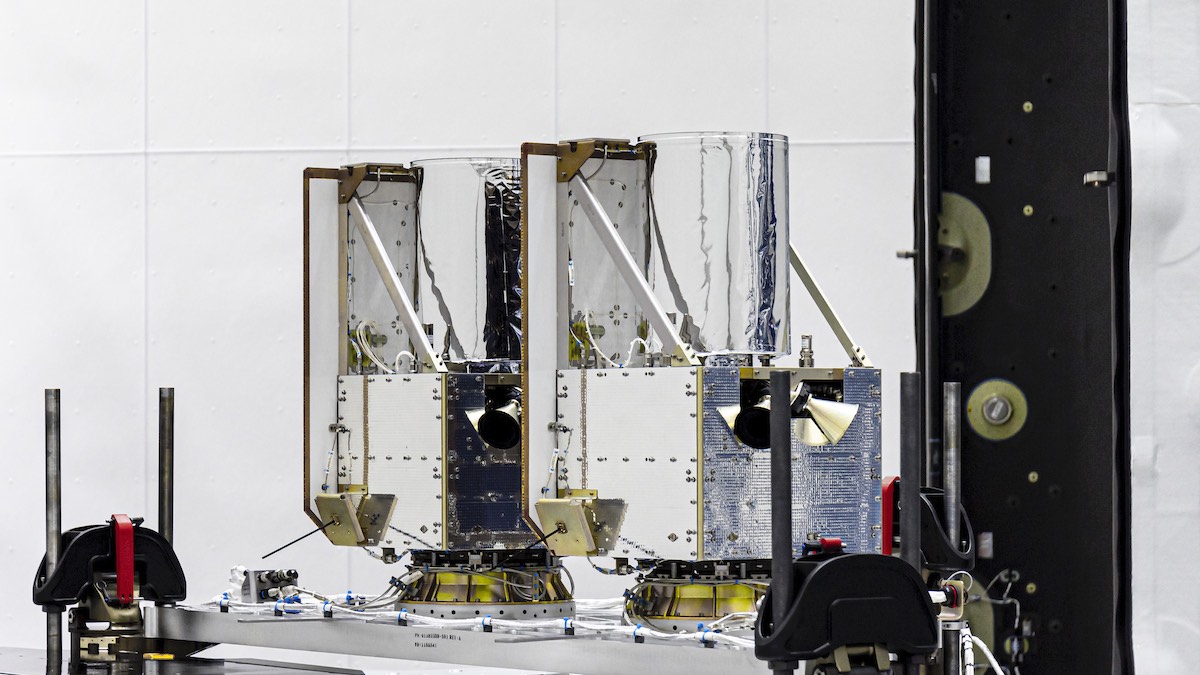
The two new BlackSky satellites will join eight others in the BlackSky fleet. Two BlackSky satellites launched Nov. 17 on a Rocket Lab mission from New Zealand, and Rocket Lab plans another launch in December carrying two more BlackSky payloads.
Expanding the constellation “will enhance the company’s geospatial capacity for data while increasing revisit rates for customers,” BlackSky said in a statement.
The surge of launches with BlackSky satellites, assuming they remain on schedule, will double the size of the company’s fleet from six to 12 spacecraft over a period of six weeks.
Another two BlackSky satellites are booked for launch on a Rocket Lab mission in 2022. The remote sensing company has ordered additional spacecraft from its manufacturer, LeoStella, based in Tukwila, Washington, a suburb of Seattle.
LeoStella is a joint venture between BlackSky and Thales Alenia Space, a major European satellite manufacturer.
BlackSky, with offices in Seattle and Herndon, Virginia, is deploying a fleet of small remote sensing satellites to provide high-resolution Earth imagery to commercial and government clients.
One big customer for BlackSky is the U.S. military and intelligence agencies. BlackSky has agreements to sell commercial imagery to NASA, the National Reconnaissance Office and the National Geospatial-Intelligence Agency.
BlackSky says the commercial market for its services include customers in transportation, infrastructure, construction, and supply chain management.
Each of the current generation of BlackSky Global spacecraft can capture up to 1,000 color images per day, with a resolution of about 3 feet (1 meter). In the future, BlackSky will deploy a third generation of BlackSky satellites with sharper resolution level of about 20 inches, or 50 centimeters.
The company uses artificial intelligence and machine learning algorithms to process and analyze imagery beamed back to Earth from BlackSky satellites. The algorithms and detect and identify objects in the images without humans in the loop, according to BlackSky.
After its last launch with Rocket Lab, BlackSky put its satellites through systems checkouts and started taking images. The automated image analysis system processed the first images within 14 hours of launch. BlackSky released a view of a port in Antofagasta, Chile, to demonstrate the company’s ability to rapidly activate and “operationalize” a satellite.
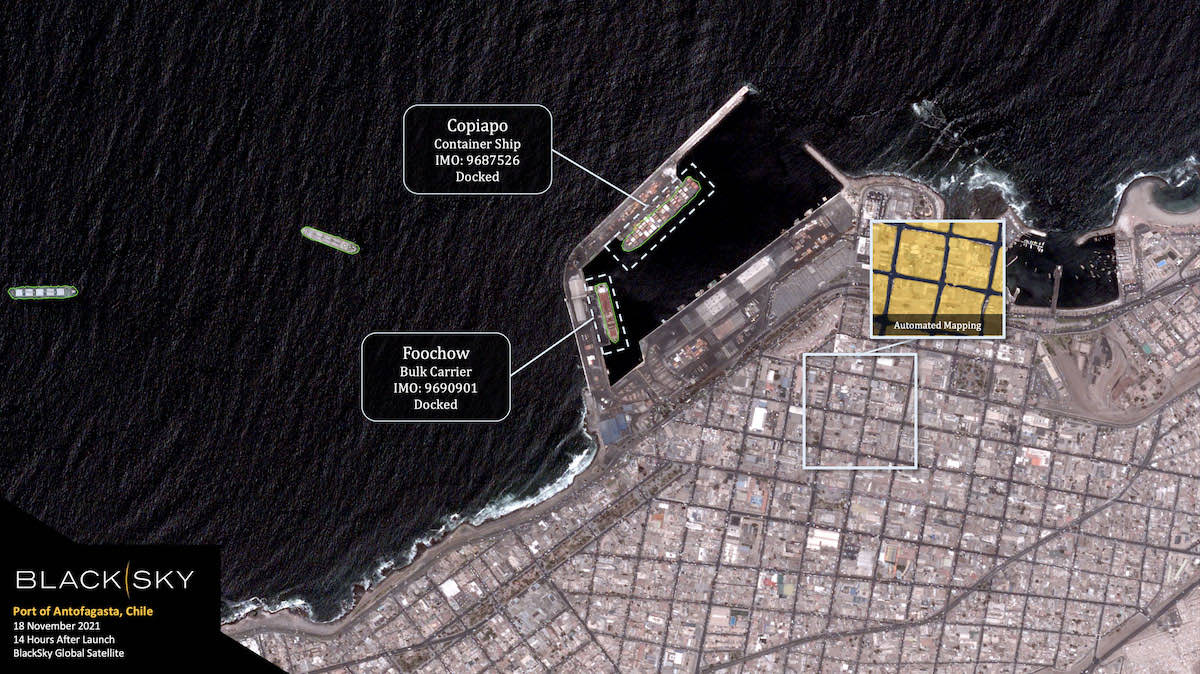
“Growing BlackSky’s constellation and increasing our rapid-revisit monitoring capabilities is about more than just getting satellites into space,” said Nick Merski, BlackSky chief operations officer, in a statement. “The key value to customers is how quickly we incorporate data from these sensors into our AI architecture. It’s about the prompt delivery of top quality, automated services for insights that our customers can trust.”
SpaceX provides relatively low-cost rides to orbit to external customers by selling extra capacity on its Starlink missions. The launch company also launches dedicated rideshare flights, called Transporter missions, with dozens of small satellites from a range of U.S. and international customers.
According to SpaceX’s website, the company charges $1 million to launch a 440-pound (200-kilogram) satellite on a rideshare mission. That’s significantly lower than any other launch provider, including small satellite launchers like Rocket Lab’s Electron.
But Rocket Lab and other smallsat launch companies can satellites into orbit on dedicated rides, giving operators more flexibility to choose their altitude and inclination.
SpaceX will deploy the two BlackSky satellites into a 267-mile-high (430-kilometer) orbit at an inclination of 53 degrees, according to Spaceflight, the rideshare launch broker.
The Falcon 9 rocket will deploy its stack of Starlink payloads after releasing the BlackSky satellites. SpaceX has not said how many Starlink satellites are on-board the mission set for launch this week.
The previous Starlink mission Nov. 13, which kicked off deployment of a new phase of the Starlink network, carried 53 satellites, all with inter-satellite laser links. It was not clear Tuesday whether the addition of the BlackSky satellites will reduce the number of Starlink spacecraft carried on the next mission.
Quelle: SN
----
Update: 3.12.2021
.
Start von SpaceX’s 31th Starlink v1.0 mission and 32th Starlink launch
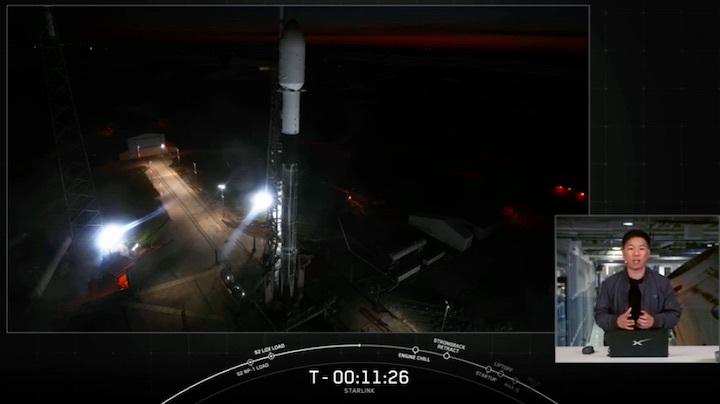




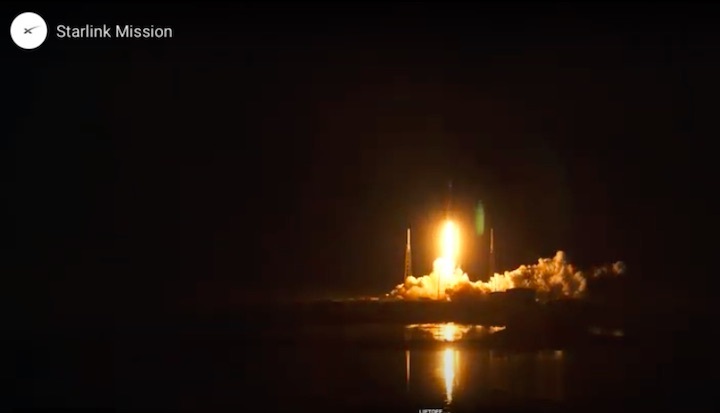

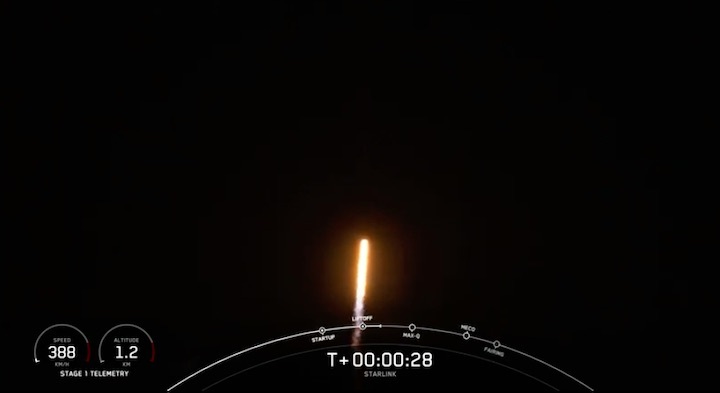
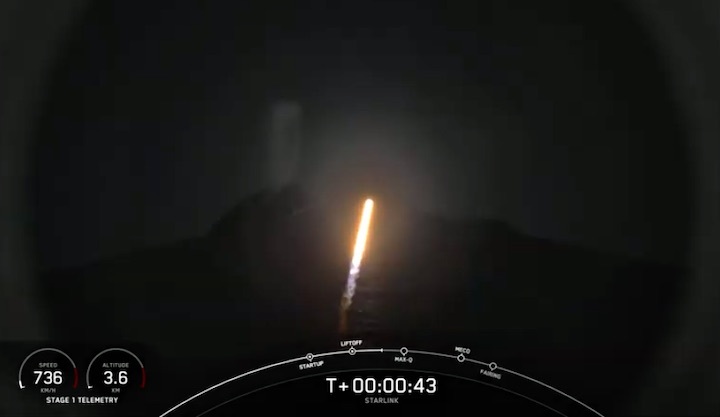



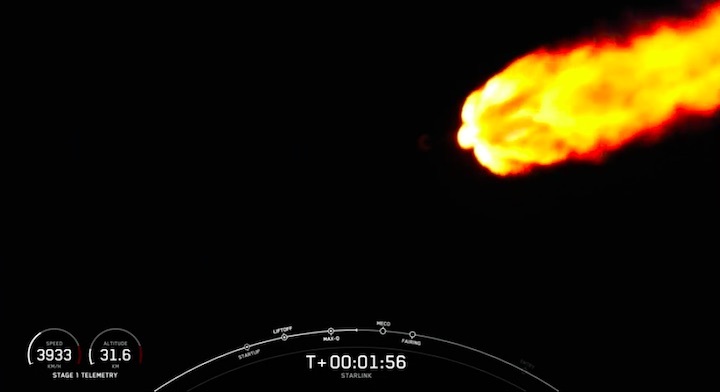

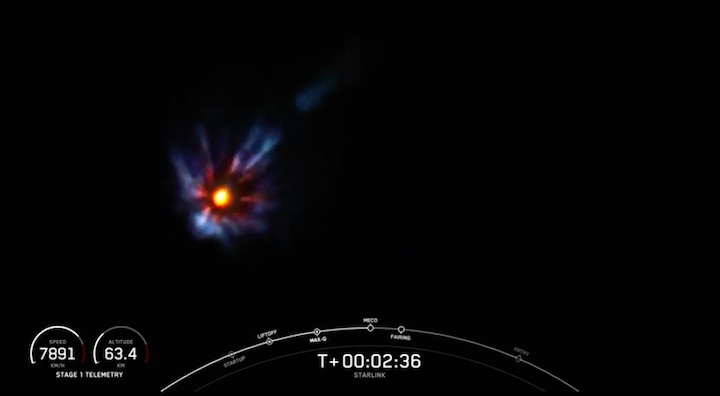





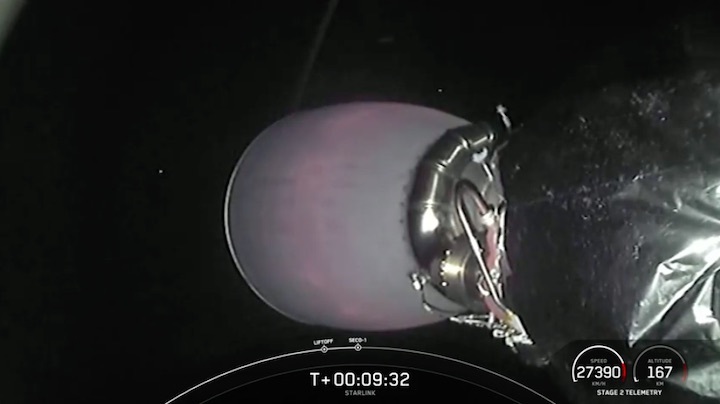

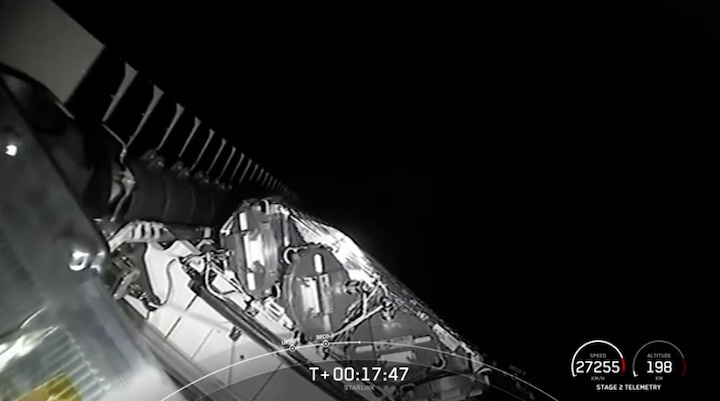

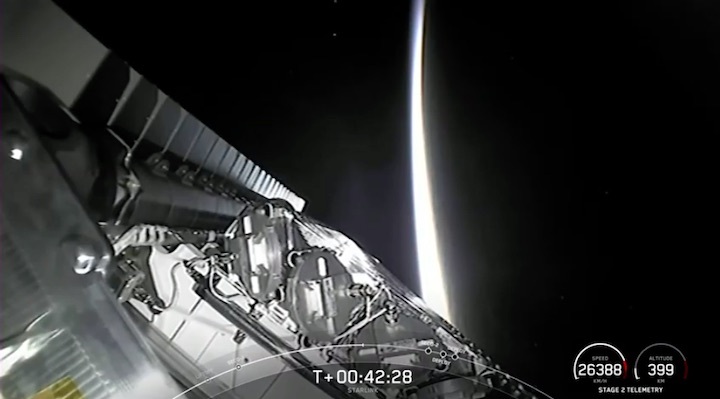








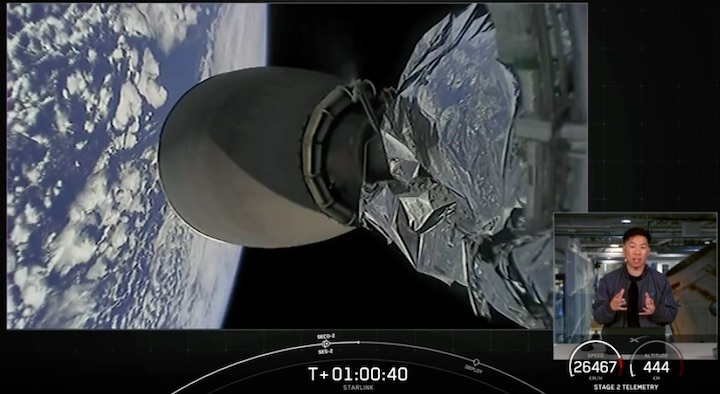
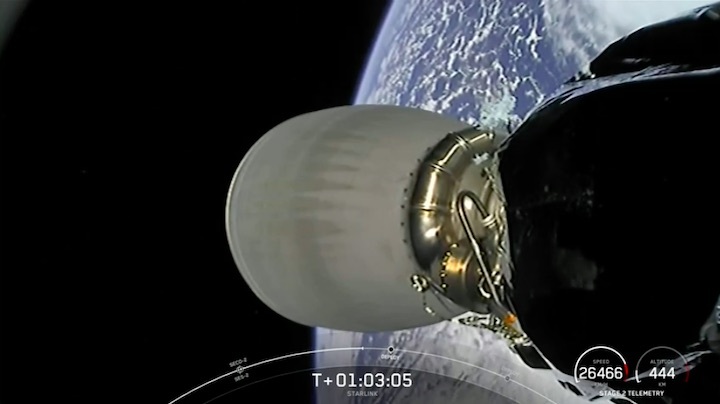
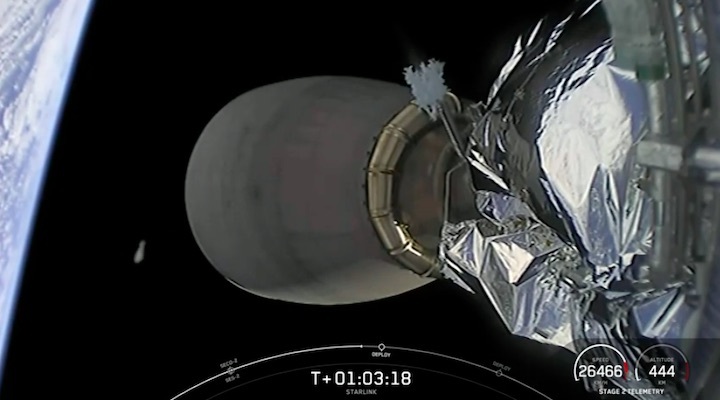
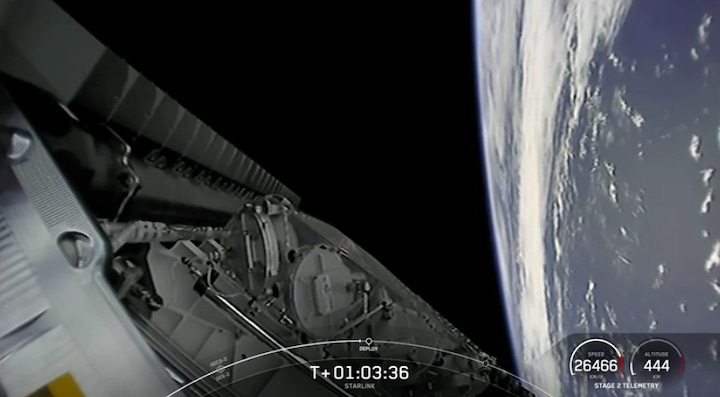
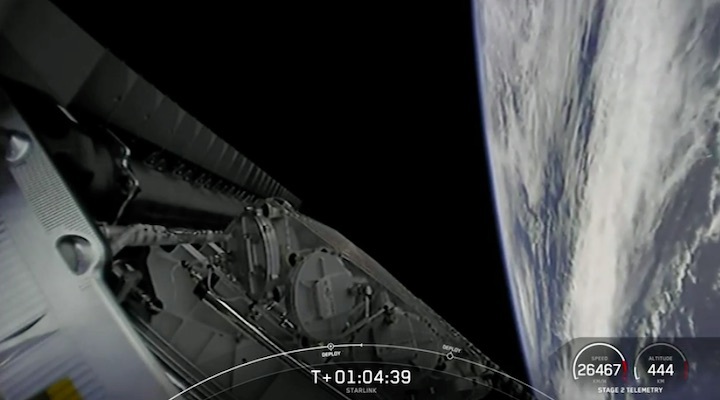
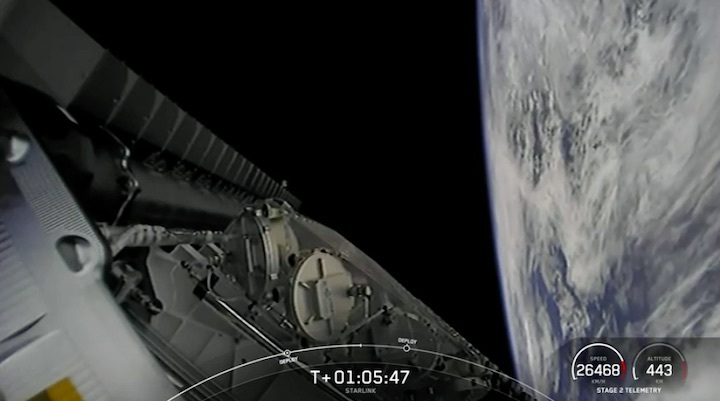



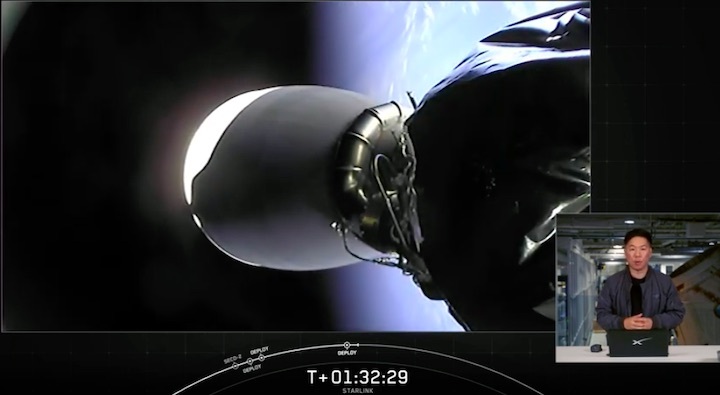



Quelle: SpaceX
+++
SpaceX breaks annual launch record as it deploys 48 more Starlink satellites
TAMPA, Fla. — SpaceX deployed 48 more satellites for its Starlink broadband constellation Dec. 2, along with two remote sensing spacecraft for BlackSky in a mission that breaks the record for Falcon 9 launches in a calendar year.
All satellites successfully separated from the Falcon 9 in low Earth orbit, according to SpaceX, after lifting off 6:12 p.m. Eastern from the Space Launch Complex 40 in Cape Canaveral, Florida.
After completing its mission, the Falcon 9’s reusable first stage successfully performed its ninth landing as it touched down on a drone ship in the Atlantic Ocean.
This marks SpaceX’s 27th Falcon 9 mission so far this year, beating the previous record of 26 that the company set in 2020.
Many of the Falcon 9 missions in 2021 have carried payloads for Starlink, and SpaceX has now launched more than 1,890 satellites for the broadband network as it builds out global coverage.
However, pandemic-related supply chain issues have been delaying the roll out of Starlink user terminals, which SpaceX has been heavily subsidizing to encourage adoption.
The Federal Communications Commission approved a new Starlink antenna Nov. 10 that SpaceX has said would be cheaper to make.
SpaceX is investing “massive capital” to be able to produce several million end-user terminals per year, according to an email from SpaceX founder Elon Musk to employees that was obtained by SpaceNews, and first reported by SpaceExplored.com.
But those terminals will depend on the additional bandwidth that Starlink’s second-generation Starlink satellites will provide, Musk added.
The email warned employees that SpaceX risked bankruptcy if the company did not increase production of Raptor engines that power the Starship vehicle the company is developing, which Musk said will be critical for deploying Starlink’s second-generation network.
“Satellite V1 by itself is financially weak, whereas V2 is strong,” he wrote.
Quelle: SN
